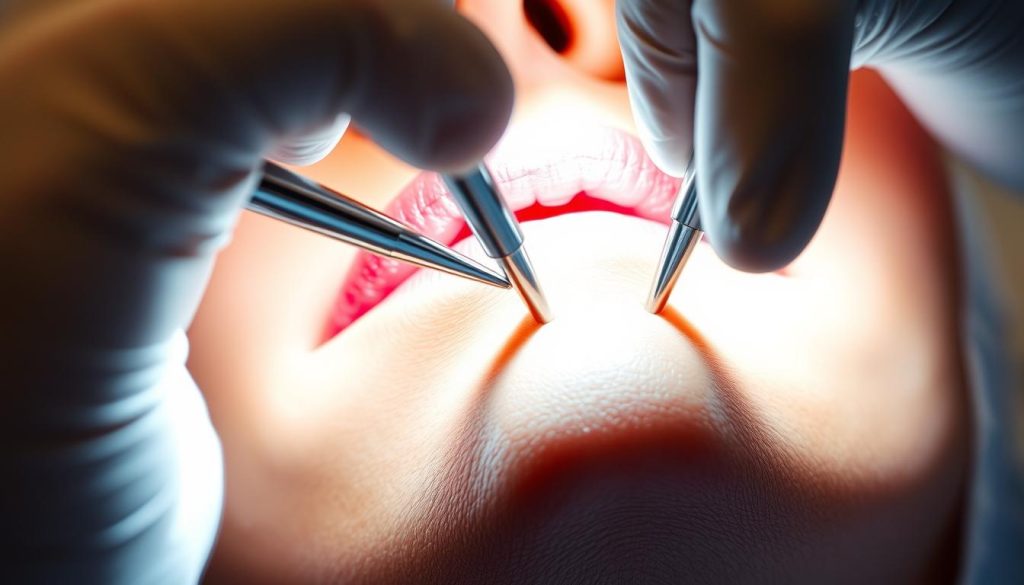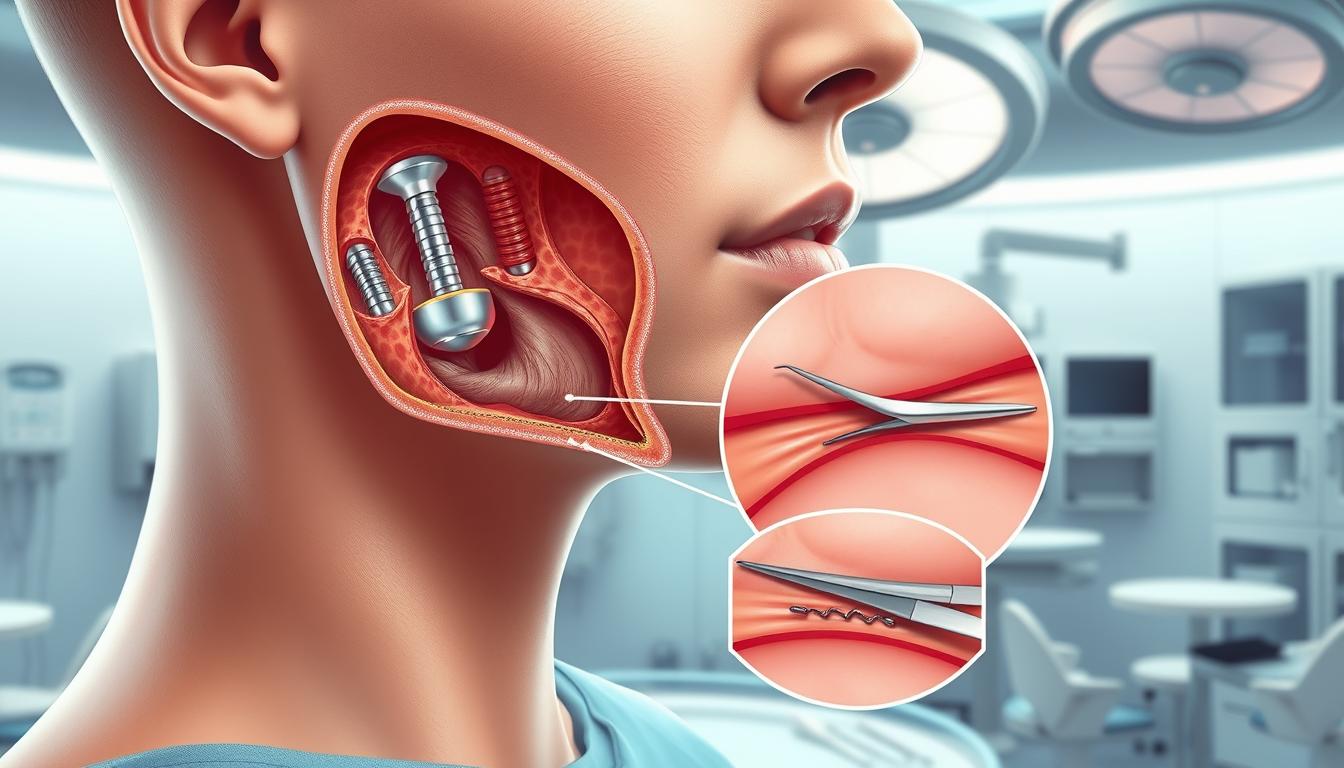Chin enhancement surgery, also referred to as genioplasty, is a procedure designed to improve the contours of the chin, neck, and jawline. By augmenting the size and shape of the chin, it achieves a more naturally attractive balance between facial features.
When performed by a qualified, experienced surgeon, this surgery can provide a permanent solution to improve a weak or recessed chin. Various procedures are available, including implant-based augmentation and bone repositioning, each offering distinct advantages for different patient needs.
Key Takeaways
- Chin surgery encompasses various procedures to reshape, resize, or reposition the chin.
- Genioplasty and mentoplasty are surgical interventions that address aesthetic and functional issues.
- Modern techniques include implant-based augmentation and bone repositioning procedures.
- Advanced techniques allow for more precise, customized results with reduced recovery times.
- This comprehensive guide explores different types of chin surgery procedures and their benefits.
Understanding Chin Surgery

Chin surgery is a cosmetic procedure aimed at improving the appearance of the chin, thereby enhancing overall facial aesthetics. It is designed to address various concerns related to the chin’s shape and size.
What is Genioplasty and Mentoplasty
Genioplasty and mentoplasty are terms often used interchangeably with chin surgery. These procedures involve modifying the chin to achieve a more harmonious facial profile. Genioplasty typically refers to surgical procedures that involve the bone, while mentoplasty can include the use of implants.
Common Reasons for Seeking Chin Surgery
Many individuals seek chin surgery to correct a recessed or “weak” chin that creates an imbalance in their facial profile. Others may pursue it to define their jawline and create a clearer distinction between the chin and neck. Functional issues, such as difficulties with chewing, can also motivate patients to consider chin surgery. By improving the chin’s appearance and function, individuals can achieve a more balanced and aesthetically pleasing facial structure.
Types of Chin Surgery Procedures
The field of chin surgery offers a range of surgical techniques, from chin implant surgery to osseous genioplasty. These procedures are designed to address various aesthetic and functional concerns related to the chin.
Chin Implant Surgery
Chin implant surgery involves the insertion of a synthetic implant to enhance the size and shape of the chin. This procedure is often chosen for its simplicity and effectiveness in achieving a more balanced facial profile. The implant is typically made of a durable material that is well-tolerated by the body.
Key aspects of chin implant surgery include:
- Minimally invasive with a relatively quick recovery
- Reversible, as the implant can be removed if necessary
- Customizable to meet individual patient needs
Osseous Genioplasty (Bone Repositioning)
Osseous genioplasty involves the surgical repositioning of the chin bone to achieve the desired projection, height, or width. This technique allows for three-dimensional modification of the chin, making it suitable for more complex cases.
During osseous genioplasty, an incision is made inside the mouth, and the chin bone is cut and moved into a new position. The jaw is not broken; only the chin button is moved, allowing for a more youthful appearance due to the tightening of neck tissues.
| Procedure | Description | Benefits |
|---|---|---|
| Chin Implant Surgery | Involves inserting a synthetic implant to enhance chin size and shape | Minimally invasive, reversible, customizable |
| Osseous Genioplasty | Surgical repositioning of the chin bone | Three-dimensional modification, tightening of neck tissues, more youthful appearance |
Benefits of Chin Surgery
Chin surgery offers numerous benefits, both aesthetically and functionally. This surgical procedure can significantly enhance the overall appearance of the face while addressing various functional issues.
Aesthetic Improvements
One of the primary reasons individuals opt for chin surgery is to achieve aesthetic improvements. By reshaping or augmenting the chin, patients can attain a more balanced facial profile, which can boost their confidence and overall satisfaction with their appearance. Chin reduction surgery, for instance, can decrease the length, width, or overall size of the chin, making it more proportionate to other facial features.

Functional Benefits
Beyond aesthetic enhancements, chin surgery can also provide significant functional benefits. For example, it can address issues related to dental occlusion and bite alignment. Patients with micrognathia (an abnormally small jaw) can experience improved breathing and reduced symptoms of sleep apnea following chin advancement surgery. Additionally, corrective chin surgery can improve chewing efficiency and reduce uneven wear on teeth by correcting chin asymmetry.
- Reconstructive chin surgery can restore both appearance and function after trauma or cancer treatment.
- Some patients experience relief from temporomandibular joint (TMJ) disorders after undergoing chin surgery that improves jaw alignment.
The Chin Surgery Procedure
Understanding the chin surgery procedure is crucial for patients considering this cosmetic surgery. The process involves several stages, from pre-surgical consultation to the actual surgery.
Pre-Surgical Consultation and Planning
The journey to a successful chin surgery begins with a thorough consultation. During this phase, the surgeon assesses the patient’s facial structure and discusses their aesthetic goals. Advanced imaging techniques may be used to simulate potential outcomes, allowing patients to visualize the results.
Anesthesia Options
Chin surgery is typically performed under general anesthesia or local anesthesia with sedation. The choice of anesthesia depends on the complexity of the procedure and the patient’s comfort level. Effective anesthesia ensures a pain-free experience during surgery.
Surgical Techniques and Incisions
The surgical technique involves making a small incision either underneath the chin or inside the mouth. Through this incision, the surgeon creates space for the chin implant and fits it around the chin bone. The choice between an external or intraoral incision depends on various factors, including the type of implant and the patient’s anatomy.
| Surgical Approach | Incision Location | Advantages |
|---|---|---|
| External | Underneath the chin | Less technically challenging |
| Intraoral | Inside the mouth | No visible scarring |
Recovery After Chin Surgery
Chin surgery recovery involves several stages, from immediate post-operative care to managing swelling and discomfort. The initial outcome of the surgery may be obscured by visible swelling, which can take several months to fully dissipate.
Immediate Post-Operative Care
After chin surgery, patients are advised to follow a strict post-operative care regimen. This includes consuming a liquid-only diet for a day or two and using prescribed anti-inflammatory medications and analgesics to manage discomfort.
Timeline for Recovery
The recovery timeline varies among individuals, but generally, some temporary numbness on the lower lips after chin surgery typically returns to normal within several weeks. Full recovery can take several months.
Managing Swelling and Discomfort
Managing swelling is crucial for a smooth recovery. This can be achieved by avoiding sodium-rich foods, staying well-hydrated, and possibly undergoing lymphatic drainage massage as recommended by some surgeons.
| Care Aspect | Recommendation |
|---|---|
| Diet | Liquid or soft diet for the first few days |
| Swelling Management | Avoid sodium-rich foods, stay hydrated |
| Pain Management | Prescribed anti-inflammatory medications and analgesics |

Potential Risks and Complications
Understanding the potential risks and complications associated with chin surgery is crucial for making an informed decision. While chin surgery is considered safe when performed by qualified professionals, there are risks involved.
Common Side Effects
Common side effects of chin surgery include swelling, bruising, and discomfort. These are typically temporary and resolve on their own within a few weeks. Proper post-operative care can help minimize these effects.
Serious Complications to Be Aware Of
More serious complications, though rare, can occur. These include infection at the surgical site, implant malposition or migration, and bone resorption beneath the chin implant. In osseous genioplasty, there are risks related to bone healing, such as malunion or nonunion of the repositioned chin segment. Adverse reactions to anesthesia are also a potential risk, underscoring the importance of having the procedure performed by qualified professionals in accredited facilities.
Making an Informed Decision About Chin Surgery
Understanding the intricacies of chin surgery is vital for potential patients. To make an informed decision, one must consider several key factors, including the surgeon’s expertise and the type of procedure best suited to their needs.
Choosing the right surgeon is crucial, as they should have extensive experience in facial cosmetic surgery, particularly in chin augmentation procedures. Patients should review before-and-after photos and schedule consultations to assess the surgeon’s work.
It’s also important to understand the differences between chin augmentation techniques, such as implants versus osseous genioplasty, and to consider combination procedures like rhinoplasty or neck liposuction for more comprehensive facial balancing.
Ultimately, the decision to undergo chin surgery should be made with realistic expectations about results, recovery, and potential complications, ensuring patient satisfaction and optimal outcomes.
FAQ
What is the difference between genioplasty and mentoplasty?
Genioplasty and mentoplasty are often used interchangeably to describe chin augmentation or reduction procedures. However, genioplasty typically refers to a more complex procedure that involves repositioning or reshaping the jawbone, whereas mentoplasty usually involves the insertion of a chin implant.
How long does it take to recover from a chin implant procedure?
The recovery time for a chin implant procedure can vary, but most people can expect to return to their normal activities within a few weeks. Swelling and bruising typically subside within a few days to a week, and the implant usually becomes less noticeable as the swelling decreases.
What are the risks associated with chin augmentation?
As with any surgical procedure, there are risks associated with chin augmentation, including infection, numbness, and scarring. However, these risks can be minimized by choosing a qualified and experienced surgeon and following their instructions carefully.
Can chin surgery improve the overall appearance of my face?
Yes, chin augmentation or reduction can significantly improve the overall appearance of the face by enhancing the balance and harmony of the facial features. A well-proportioned chin can make a significant difference in the overall aesthetic of the face.
What type of anesthesia is used for chin surgery?
The type of anesthesia used for chin surgery can vary depending on the individual and the complexity of the procedure. Some procedures may be performed under local anesthesia with sedation, while others may require general anesthesia.
How long do the results of chin surgery last?
The results of chin surgery can be long-lasting, but the longevity of the results depends on various factors, including the type of procedure, the individual’s overall health, and their lifestyle habits. With proper care and maintenance, the results of chin surgery can last for many years.
